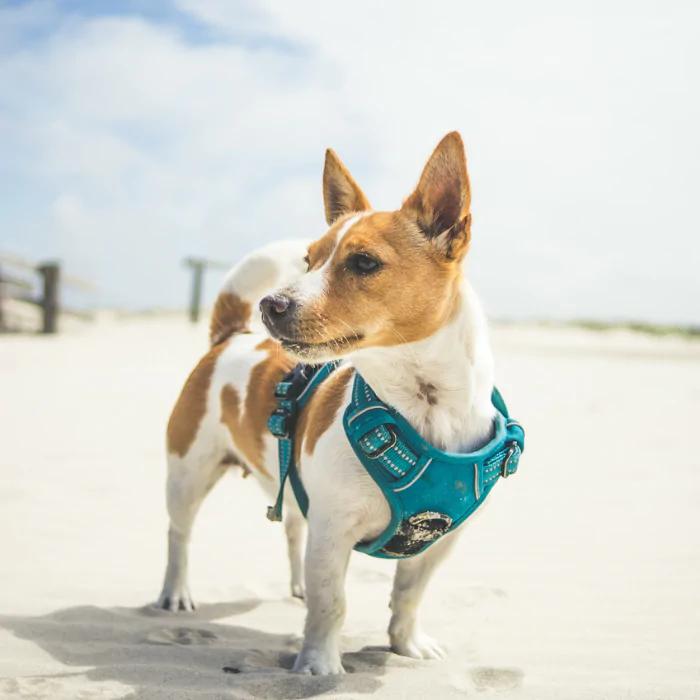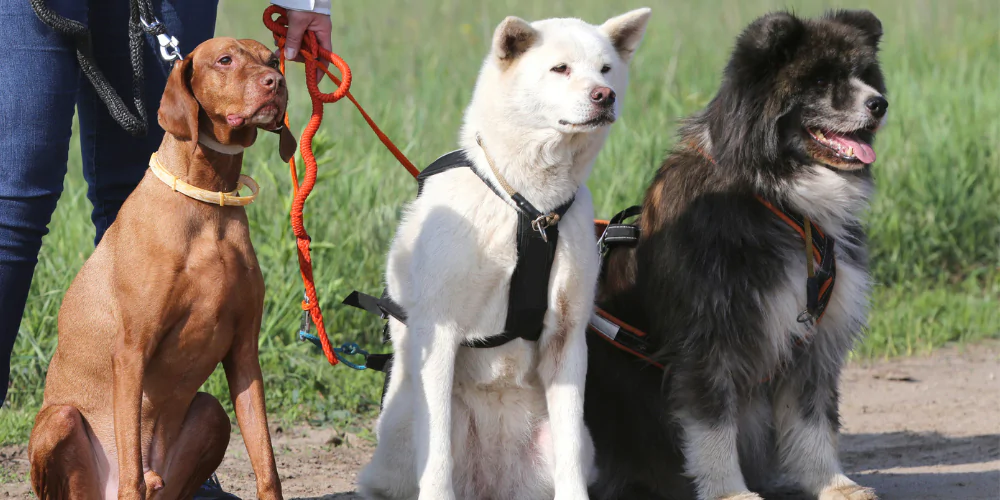
Dog collar or harness: What’s right for my pet?

Kelly Johnstone
22 July 2021 | 4 minutes read
Are you wondering whether a collar or harness is better when walking your dog? Let’s look at the differences between the two, weigh up the pros and cons, and help you make the right choice for your pet.
Table of contents
- Dog collars
> Pros of using a dog collar
> Cons of using a dog collar - Dog harness
> Pros of using a dog harness
> Cons of using a dog harness - Is a harness or collar better for a dog?

Dog collars
Dog collars come in all sizes and materials. In leather or nylon and even different shapes depending on the breed of dog. For example, the Martingale collar is designed especially for dog breeds like Greyhounds and Whippets, as their narrow heads mean they are more likely to slip out of a normal sized collar.
Legally, all dogs must wear a collar when outdoors. The collar must also display the pet owner’s name and address.
A dog lead that attaches to your dog’s collar is a common option for pet owners when walking their dog.
Here are some pros and cons of a dog collar:
> Pros of using a dog collar
Typically, your dog will wear their collar all day. This might make it a more comfortable and convenient option for your dog when out walking.
Should your dog go missing, their collar has the details to help with reuniting you and your pet. It also visually communicates that your dog has a home, so the person who finds them knows they’re not a stray.
A collar may also be a better option for longer walks. Unlike a harness, there isn’t the risk of the skin chaffing around your dog’s legs or elbows.
> Cons of using a dog collar
If your dog tends to pull on the lead when out for walkies, the collar could cause them pain and result in injuries as it puts pressure on their neck.
Because of the pressure the collar can put on their neck, a dog collar and lead combination might be unsuitable for walking dogs with respiratory conditions or Brachycephalic (flat-faced) breeds.
Similarly, the choke, prong or pinch collars are not recommended by the RSPCA. While some pet owners use them to train their dogs to stop pulling on the lead, they cause discomfort for your dog, which could lead to both physical and emotional damage.
It’s important to make sure your dog’s collar fits correctly. You can check this by seeing if you can fit two fingers under their collar. If you can’t, it’s too tight and if you can fit more than two fingers under, then it’s too loose.

Dog harness
There are different types of dog harnesses available. These include front attaching harness, where the clip is on the dog’s chest, or back attaching, where the clip is on the dog’s back.
Here are some pros and cons of a dog harness:
> Pros of using a dog harness
A dog harness is much better for dogs who typically pull on the lead as it makes it easier for pet owners to control their dog when out walking. It’s also more difficult for your dog to slip out of a harness than it is with a collar.
One of the other benefits of a harness is the force of a lead pull is spread across more parts of your dog, as opposed to just their neck as with a dog collar.
For Brachycephalic (flat-faced) breeds, harnesses tend to make a better option as collars can cause too much pressure in the neck and impact their breathing.
> Cons of using a dog harness
Your dog may be a little unsure at wearing a harness at first. But, if you gradually introduce your dog to the harness, they may soon get used to wearing one on walks.
Harnesses can cause skin chafing. This is more common when the harness isn’t attached correctly, it’s not a good fit or if your dog is an excessive lead puller.
A dog harness may be less suitable if your dog has long fur. It can sometimes get tangled or cause matting of the fur.

Is a harness or collar better for a dog?
There’s no right or wrong answer when it comes to a dog collar or dog harness. You should take into account factors such as how much they tend to pull on their lead, how likely they are to escape their collar and how comfortable they would feel wearing a harness as an alternative.
If you’ve recently welcomed a puppy into your family, when you start puppy lead training, you might want to introduce them to both a collar and harness. This way you can properly weigh up the best option for your dog.
For older dogs, it’s likely they’ll already be used to wearing either a collar or harness. But, with a little time and patience, your dog can soon become familiar with their new walking companion.
Ultimately, you should choose whichever one your dog is most comfortable with and the one you think will keep your canine safe while out on your walks.
We’re fighting for more inclusive dog insurance. That’s why we put you in control of your dog’s insurance. Let’s all raise a hand, paw or claw together towards fairness for all.


